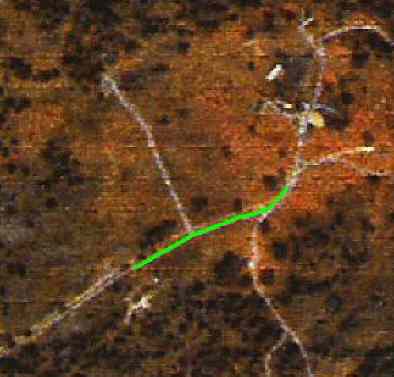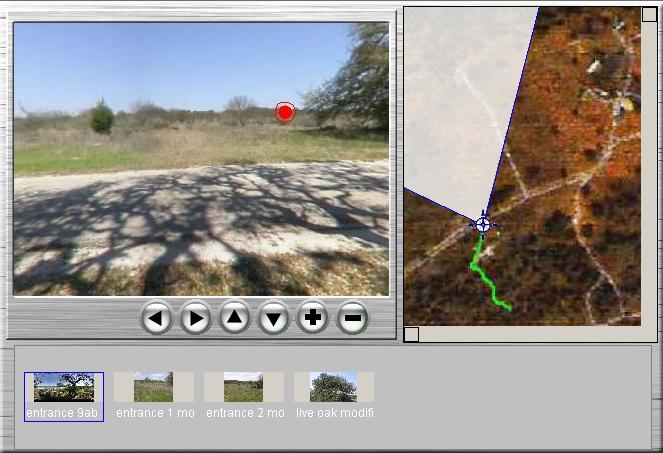Nature Trail Stop 1: Entrance
The map below highlights the road we are taking to the nature trail entrance.

Freeman Ranch. Modified from Barnes, Liang, Jessup, Ruiseco, Phillips, and Reagan, 2000.
Savanna Parklands
Across the street from the nature trail entrance, we see a field of grasses and flowers with clusters of trees interspersed through it. You can see this landscape in the virtual tour of this stop on the nature trail (see link below). This grassland scene with isolated clusters of trees and shrubs is characteristic of a savanna. Portions of the Freeman Ranch are upland areas, which are topographically raised regions. Vegetation in these upland areas has historically consisted of savanna parklands as we see here near the nature trail entrance. If you were to travel to other areas in the Edward’s Plateau, you would see scenes similar to this one.
The table below specifies what percentage of the total species at Freeman Ranch falls into each of the eight plant growth forms. This table provides evidence that the Freeman Ranch supports a savanna ecosystem as described above.
Growth Form |
% of Species at Ranch |
Forb |
57 |
Graminoid |
21 |
Tree+shrub |
14 |
Vine |
5 |
Succulent |
2 |
Epiphyte |
<1 |
Parasite |
<1 |
Plateau Live Oak
Near the entrance of the nature trail, we see one of the tree clusters up closer (click on the hotspot link in the tour above). This tree cluster is typical of those found here at the ranch. It consists of a central “nurse” tree, which is a live oak (scientific name: Quercus fusiformis). It is thought by scientists that this live oak aids in establishing the plants underneath its canopy, or the understory. The live oak seems to change the physical and chemical properties of the soils directly near it. These changes then potentially increase the levels of moisture and nutrients in the soil. These factors are thought to contribute to the growth of the understory; and, thus, the live oak is seen by some as a “nurse” plant.
Live oaks have resided at Freeman Ranch for long periods of time, as suggested by their large trunks. Some live oaks have a trunk diameter (at breast height) of 100 cm (39 inches) or more. The savannas in this region have historically been maintained by natural fires. However, the live oaks are able to survive these fires because of their thick outer bark and their capability of re-sprouting from the base of their trunks. They also are tolerant of drought, various slopes, various soils, and hot and cold temperatures. The live oaks do have one main limitation; they must grow in well-drained areas. We will see the affect of this characteristic in the vegetation distribution of the Limestone Pit which is several stops further on the tour.
After you have completed the Nature Trail Entrance section of your field notes, we can go on to the next stop, which is Cacti Alley. The first species of our tour is already recorded for you in the species inventory table as an example of how to record the other species.
